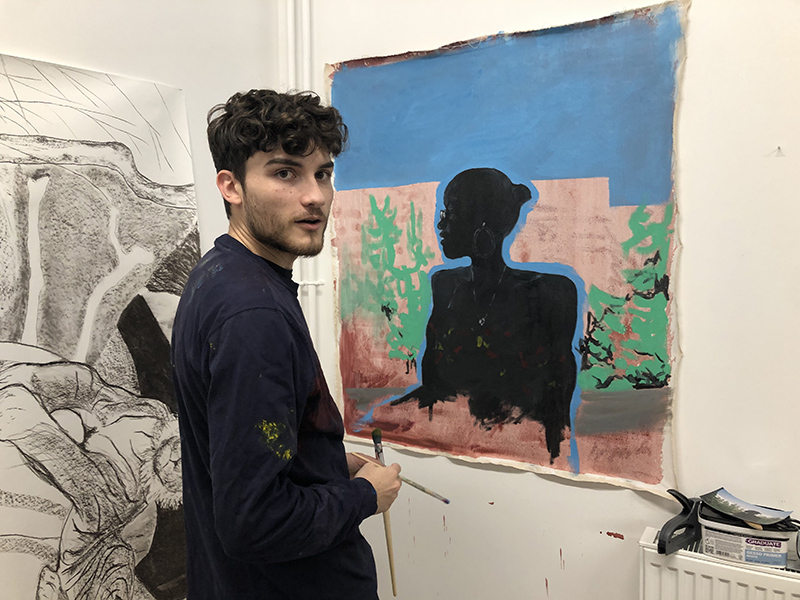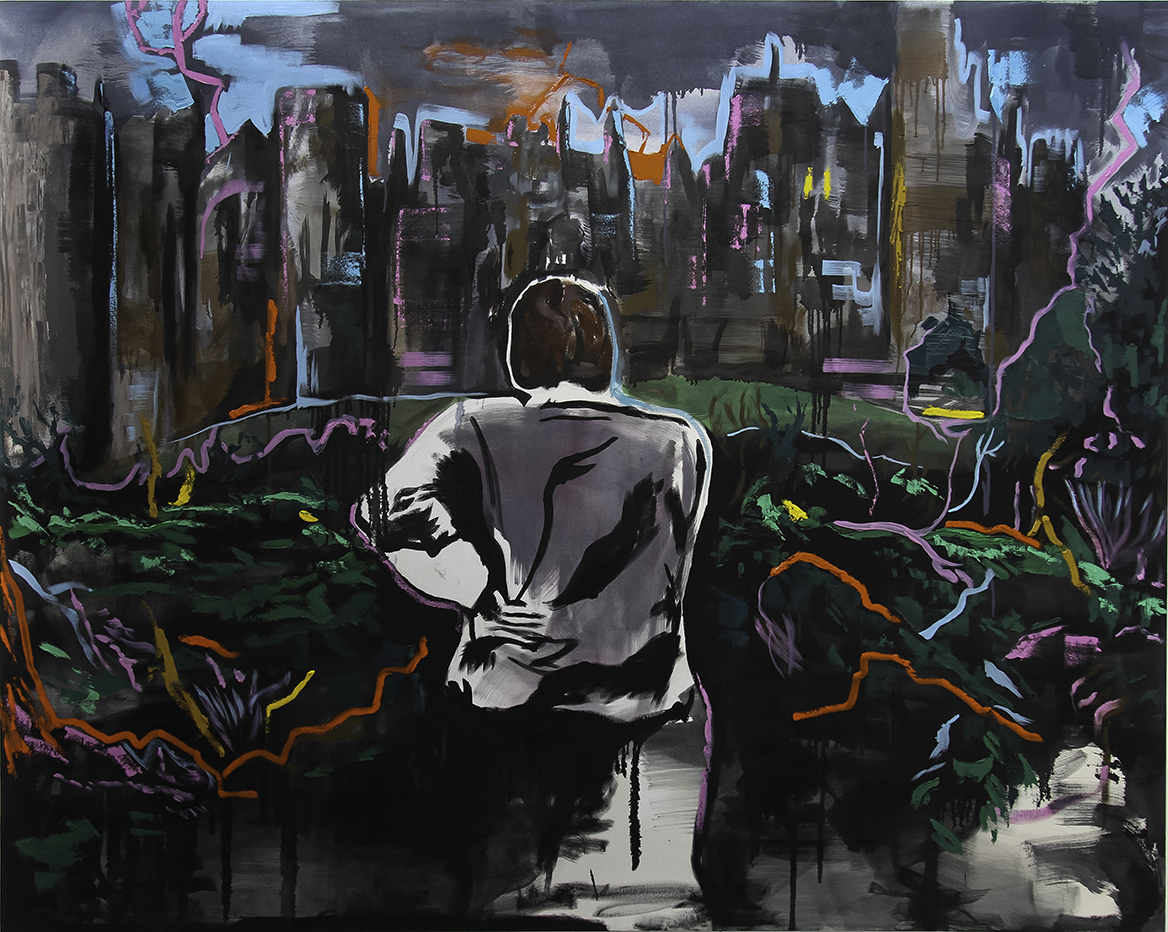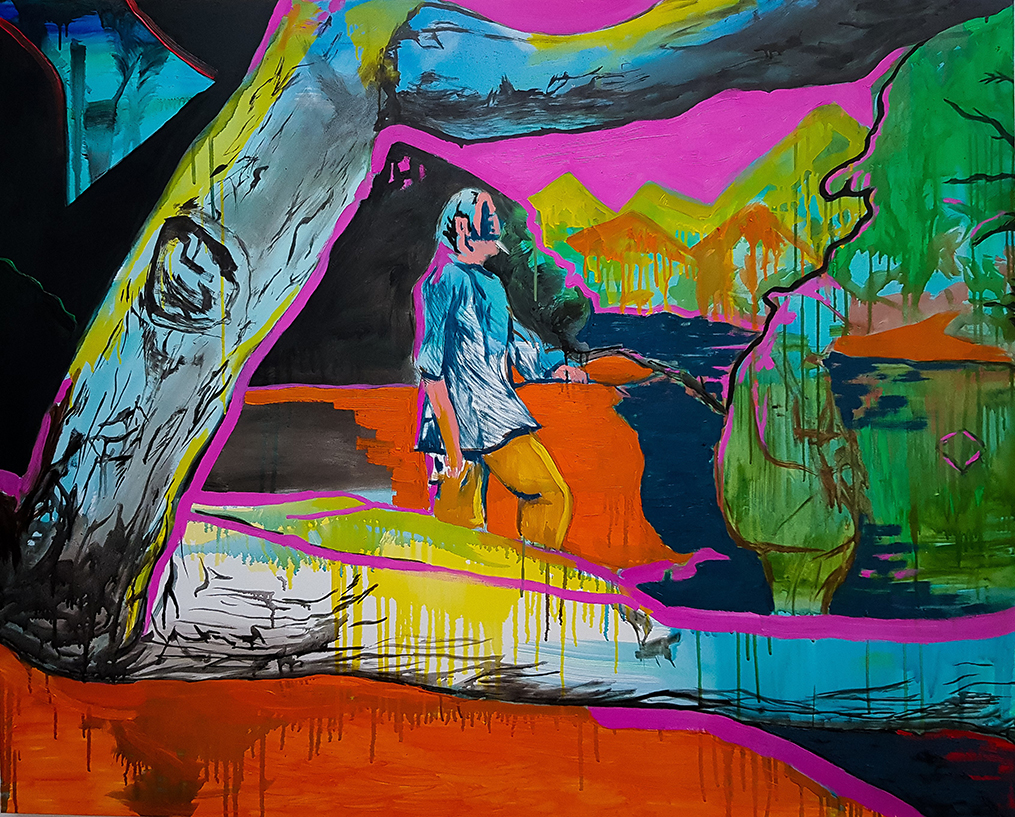I try to create paintings that are something of an in-between space, a contrast between the real and the imagined. My aim is to push the recognisable elements of the figurative and the painterly style so far that there is a near collapse in the image.
Pushing the boundaries of what a medium can do and what painting should be is at the core of Jack Hughes’ journey.

In studio.
How did your tryst with art begin?
I have always been a creative person. My earliest memories are of me always drawing pictures and comparing them with my older brother’s. I also had a folder full of drawings where I had created characters for the games we played. Everyone responds well to praise and I enjoyed drawing pictures and hearing people compliment them as a child.
I didn’t really see art as anything more than a pastime until I was 17. My college was in Deeside, on the north coast of Wales. My tutor, Richard Dunn, really gave me the idea that I was good enough to do this as a career. Since then it’s been nothing but oil painting. I have since graduated from Arts University Bournemouth with a BA (Hons) in Fine Art. I now paint in a studio in London and hope to do a master’s degree next year.
What inspires you? Take us through your process and continuous framework of reference.
Literature, cinema, my peers, nature, and nostalgia. I find it difficult to nail down what consistently inspires me throughout my work. I’m a bit of a sponge at the moment. I just see things, read things and they creep into my work. I’m at an early stage of my career and I find my work changing every time I go back to the studio. I have recently been really inspired by Jeff Vandermeer, who writes speculative, weird, environmentally charged science fiction novels.
I try to create paintings that are something of an in-between space, a contrast between the real and the imagined. My aim is to push the recognisable elements of the figurative and the painterly style so far that there is a near collapse in the image. Have I achieved it yet? Do I know what that looks like? I don’t think so and that’s why I keep going back to it. My process is a constant battle between going too far or not far enough. If it was easy, I would get bored. I find it stimulating to have photographs and grabs from films around me. They help me get started when I have a blank canvas in front of me, but I soon find the medium takes over and I follow it where it goes.

The Land Surveyor, 2018.
What is the primary role of an artist? How do you describe yourself in the context of challenging people’s perspectives via your work and art?
My primary role is to create art. I think my aim, along with a lot of other painters, is to challenge the general public’s idea of what painting should be. I always aim to change what painting is, and push the limits of what you can do with the medium. I believe the process is more important than the source material and the work will be read differently depending on the audience and I can’t change that.
My aim is to generate an emotional response from the audience, whether intended or not. If people stop and look a little closer, the job is done. It doesn’t matter what I think my work is doing because the viewer will always have their own perspective on what’s in front of them.
How do you deal with the conceptual difficulty and uncertainty of creating work?
If something is giving me trouble, I start a new piece. If I’m struggling to start, I spend some time going through my laptop looking through my old folders full of pictures from films I was going to use for paintings but never did. If I spent all of my free time just sitting around waiting for an idea to hit me, I’d have zero paintings to my name. The uncertainty disappears through the act of making.
Of course, going to exhibitions on a day I’m feeling extra deflated helps because seeing artists I admire on Instagram makes them seem so unattainable, with their perfect photos taken by their gallerists. Seeing them in person allows you to notice the process and the imperfections that make an artist’s style. My biggest difficulty in creating work at this point in my career is either having money but no spare time, or no money and plenty of spare time. So, usually, I head to the studio overflowing with ideas I have wanted to try and execute for weeks.

The Impatience Of The Few Who Never Saw What Could’ve Been, 2019.
What are you looking for when you look at other artists’ work? Which shows, performances and experiences have shaped your own creative process? Who are your maestros? Whose journey would you want to read about?
I want to see a struggle. I think what I like to see is a journey. Signs of things that were there and a variety of mark making. There should be something I couldn’t see in a digital image of the work. I want to see mistakes and intricate details and subtle washes of colour. I think you can tell when someone has left all they had to give on a painting, there is an energy about it that resonates within you.
The first show that really made a huge impact on me was a Francis Bacon retrospective in the Tate Liverpool in 2016. I was always a huge fan of Francis Bacon as an enigmatic character with paintings to match, but nothing could have prepared me for a whole floor of The Tate filled with his works. The confidence with which he created was unbelievable. There’s a vitality and freshness to his work, which is why it still holds up to this day.
I have also taken many trips to the National Gallery in London and it never ceases to amaze me. To have generations of historic painting in one building, it never gets old. I can spend hours in there, the years of dedication behind some of the paintings really puts me in my place.
I recently went to an exhibition at Beers London by Australian painter, Adam Lee, which was really exciting. His work always blows me away. There’s always so much going on with his subject matter and application of paint, without it feeling cramped. It appears mythical and dreamlike, but doesn’t come across as too naïve or whimsical. I think there’s a lot to learn from seeing his work, about how sometimes less is more and there has to be a constant balance.
You have spent time amongst artists in flow. What have you observed?
It’s always interesting being in a shared working space because the act of making art can become a bit of a performance. If you feel you have people around you who may judge your work, you find yourself making bold gestures and trying to make interesting things happen on the spot. I have noticed this about myself and others when I might be chatting with them while they are working. For me it was a positive as I sometimes find my work, now that I am in a studio of my own, too static since I am working on my own time and the approach is more measured and lethargic.
I also found that sharing a studio space influences aspects of your work, as other people’s work rubs off on you. I was sharing a space with two painters, Meliz Sabanci and Max Hembrow. They both did really colourful work, which crept into my work. Just seeing their paintings around me every day as I worked changed the way I painted. Max, who just had a solo exhibition on King’s Road with the 508 Gallery, has a style that is heavily influenced by cubism and I found myself adding bold outlines in my work and my colour palette getting more vibrant.
I also notice that a lot of ‘studio time’ is taken up by standing or sitting around looking at half finished work and having a crisis. It’s all part of the process.

Untitled, 2016.
What is that one thing you wished people would ask you but never do?
I’m not entirely sure what question I’d like people to ask me, but I do know that I hate the question “what do you paint?” being thrown into casual conversation. It’s a trap. I’m either going to find myself describing what I want my work to look like or I say something really boring.
I think I’d rather be asked who my favourite artists are, without asking me to narrow it down to one. I couldn’t give a single name, but at the moment I am really into Peter Doig and always enjoy Bacon. Other artists whose work I really enjoy now are Adam Lee, Joshua Hagler and Andrew Salgado.
I am also really into an artist called Ben Crawford, who is represented by Boom Gallery in Australia. I really like how he takes inspiration from ordinary, everyday imagery but manages to turn them into something more sensationalised, and creates a mysticism that holds you.
Actually, I really wished someone would ask me if they could buy my work.
What are you working on now? What’s coming next season?
I’m just working when I can, trying to build up a strong body of work quietly in my studio. I’m currently working on a few paintings that have come from polaroid photographs taken when I was in Tunisia with my partner. I’m very interested in the idea of taking something like holiday photos and turning them into paintings without it becoming too kitschy. I’m also trying to bring multiple images into a painting without it seeming too disjointed, which will be a challenge.
I’m also hoping to do a series of paintings based on old photographs of my parents when they were younger. I’ll be bringing some copies back to London with me after I have been to visit them for Christmas and get started on them in the coming year.
I am aiming to do my masters in fine art in 2020 and will be looking for opportunities to sell my work via art fairs. This year will hopefully bring new ideas and opportunities to grow. I’m hoping 2019 was the calm before the storm.












Add Comment